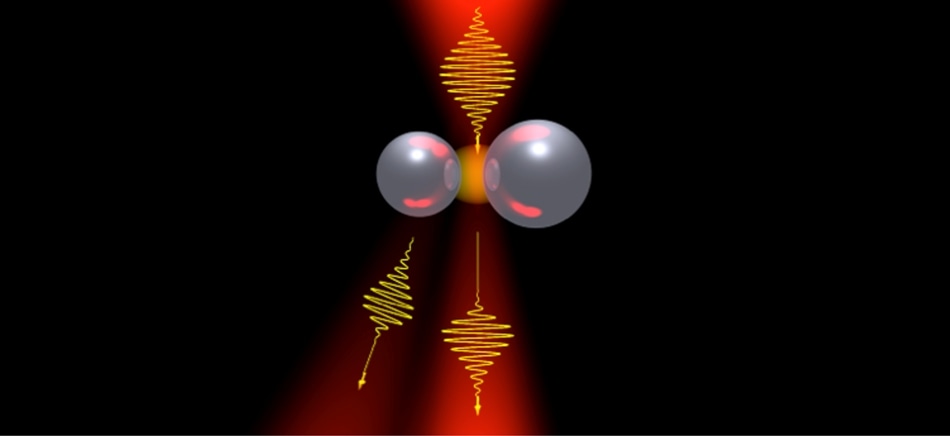Nov 17 2016
 An artist’s rendering of nonlinear light scattering by a dimer of two silicon particles with a variable radiation pattern. (Credit: Moscow Institute of Physics and Technology)
An artist’s rendering of nonlinear light scattering by a dimer of two silicon particles with a variable radiation pattern. (Credit: Moscow Institute of Physics and Technology)
A group of physicists from the Moscow Institute of Physics and Technology (MIPT), ITMO University, and The University of Texas at Austin have created a unique nanoantenna with the ability to scatter light in a specific direction based on the intensity of incident radiation. The outcomes of this research will help develop flexible processing of optical information in telecommunication systems.
Photons, which are the electromagnetic radiation carriers, do not have electric charge or mass, indicating that in contrast to electrons (whose flow in electronic circuits can be controlled by the application of a constant electric field), light is relatively harder to control. Devices such as nanoantennas allow the propagation of electromagnetic waves to be controlled to a certain degree.
One field that requires “advanced” light manipulation is the evolution of optical computers. In such devices, instead of electrons, the information is carried by photons. The speed at which information is transmitted and processed is significantly increased when light is used instead of charged particles.
The development of such computers in reality mandates the usage of specific nanoantennas with properties that can be manipulated somehow, i.e. by varying the intensity of incident light, or, for example, by applying a constant magnetic or electric field.
In the research reported in Laser & Photonics Reviews, the scientists designed an innovative nonlinear nanoantenna with the ability to change the direction of scattering of light based on the intensity of the incident wave. Silicon nanoparticles play a vital role in the proposed nanoantenna, because they produce electron plasma under harsh laser radiation.
Earlier, the researchers demonstrated the potential of employing silicon nanoparticles for ultrafast and nonlinear control of light. They then managed to control portions of light radiation that were scattered forward and backward. Then, they established a method to turn a scattered light beam in the desired direction by altering the intensity of incident light.
The authors employed the process of plasma excitation in silicon to rotate the radiation pattern of the nanoantenna. The nanoantenna is a dimer, it has two silicon nanospheres with unequal diameters. When the antenna is irradiated with a weak laser beam, it scatters the light sideways because of its asymmetric shape. The diameters of the two nanoparticles are selected so that one of the particles is resonant at laser light wavelength.
Irradiation of the resonant particle using an intense laser pulse results in the generation of electron plasma that leads to alterations in the optical characteristics of the particle. The other particle stays nonresonant, and the intense laser field has very little impact on it. In general, the size of the particles can be made virtually equal by precisely selecting the relative size of the particles as well as the incident beam parameters, such as intensity and duration, thus enabling the antenna to bounce the light beam forward.
Existing optical nanoantennas can control light in a fairly wide range. However, this ability is usually embedded in their geometry and the materials they are made of, so it is not possible to configure these characteristics at any time. The properties of our nanoantenna, however, can be dynamically modified. When we illuminate it with a weak laser impulse, we get one result, but with a strong impulse, the outcome is completely different.
Denis Baranov, Postgraduate Student, MIPT
Numerical modeling of the light scattering mechanism carried out by the researchers indicated that when a weak laser beam is used to illuminate the nanoantenna, light is scattered sideways. In contrast, if an intense laser impulse is used to illuminate the nanoantenna, electron plasma is generated within the device and the scattering pattern is rotated by 20°. This consequently enables the deflection of strong and weak incident impulses in different directions.
In this study, we focused on the development of a nanoscale optical chip measuring less than 200×200×500 nanometers. This is much less than the wavelength of a photon, which carries the information. The new device will allow us to change the direction of light propagation at a much better rate compared to electronic analogues. Our device will be able to distribute a signal into two optical channels within a very short space of time, which is extremely important for modern telecommunication systems.
Sergey Makarov, Senior Researcher, ITMO University
At present, optical fibers are used to transmit information at speeds close to hundreds of Gbps. Yet, the signals are processed very slowly, i.e. at a speed of only a few Gbps for a single element, even by advanced electronic devices. By operating at 250 Gbps, the proposed nonlinear optical nanoantenna can overcome this challenge, facilitating ultrafast optical information processing.
The nonlinear antenna created by the researchers provides more avenues for controlling light at nanoscale, which is the need of the hour to successfully produce photonic computers and other identical devices.